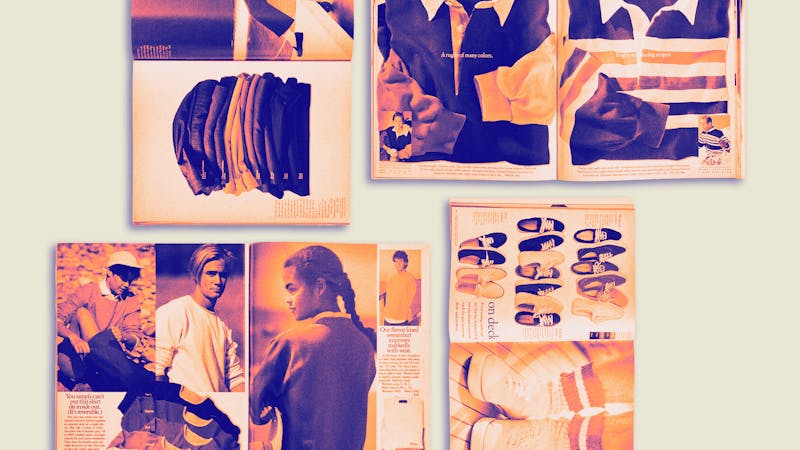For just $6 on Venmo, I scored the perfect scrapbook template to capture my "2024 recap". It was a small cardstock booklet of risograph illustrations, a printmaking technique in which 2D stencils are burned into paper. The designs featured elegant yet simple silhouettes of dynamic pottery in shades of violet–blue and taffy–pink, inspired by the artist’s summer spent at a pottery camp in China. The booklet channeled pastel and chill vibes, which I plan to fill with Polaroid photographs of friends and scenery from this year. I spent another $5 on another larger risograph: a print of a round succulent nestled in a lemonade–tinted pot.
“This,” I thought, “Would transform the bare bones of my dorm room wall into something that reflects my love for plants.” And it did.
On that icy Saturday evening, the day of Homecoming, I bought my first Penn student–made artwork with these two risographs. Bitter from Penn’s loss to Harvard University at the football game, I decided to unwind at the art fair held near the lobby of Gutmann College House. This was my first exposure to an art fair at Penn—and a breath of fresh air from the ire of the “Huck Farvard” sentiment circulating campus. Lofi beats permeated the air as visitors doodled on a crafts table near the entrance. I sketched a small plant shrub with a maroon micron pen and basic kit of wax pastels, pinning my little doodle to the board alongside the drawings and handwritten messages of other students.
On Nov. 16, student–run club The Signal orchestrated this semesterly market–style fine art fair. Organized by students for students, the event featured individual artist tables displaying their work, complete with Instagram handles and price tags. The fair showcased a wide range of media, spanning aesthetic coastal photography, intricate jewelry, and custom stickers. Digital paintings depicted verdant fantasy forests and open valleys reminiscent of anime–style role–playing games. Photographs of Venice Beach, Calif. displayed sparkling waves cascading toward the shore, capturing the motion and sound of waves rolling and splattering on the sand. I browsed through dichromatic calendars adorned with doodles and pottery–inspired silhouettes before stopping at a black–and–white screen print of a slightly eerie Sonny Angel doll. My trip ended at the jewelry table, where I admired the last silver trinket necklace, laden with small star–shaped beads and paired dice charms.
Christine Cheng (W ‘25), who is studying finance and fine arts, led this semester’s art fair. “It’s a fair [that gives] artists and students a platform to share, promote, and sell their artwork to the Penn community,” she notes. In many of Christine’s clubs, she’s surrounded by artists and designers who often lack spaces on campus that encourage student artists to connect—especially those who aren’t majoring in art or design. The Signal’s art fair addresses this gap; consequently, Christine plans to make this fair a recurring event in future semesters.
The Signal’s mission doesn’t end at fine arts engagement on campus. A hub for turning student ideas into tangible, impactful projects, this innovative group actively carries out initiatives that embrace student passion and contribute to the dialogue shaping Penn’s culture. Past projects include the Anti–Resume project, where Penn seniors highlight failures they wouldn’t normally showcase on their resumes. Failure at Penn is a yearly panel where seniors discuss the major setbacks that have defined their experiences at Penn—a great resource for those overwhelmed by the pressures of classes, clubs, and campus life at large. Before arriving at Penn, I watched a YouTube video titled “Do All Penn Students Think the Same?” to learn more about Penn's culture. I later discovered it was part of The Signal’s Where We Stand online video series. Other projects include hot chicken binges paired with discussions of university life and a satirical 200–card party game poking fun at Penn’s vocational and party scene.
“Penn's culture is very preprofessional. There's always the pressure to talk about your career, your internships,” Christine explains.
This underscores the importance of The Signal’s mission to improve student health and life on campus. According to Christine, “These projects help break down those stereotypes, [that] your life needs to be in pursuit of a career. [The Signal] promotes projects that encourage people to do things they're passionate about.”
Passion. Something I seemed to forget coming to Penn.
Amidst the whirlwind of career panels, coffee chats, and internship applications swarming my mind, I often lose sight of why I came here in the first place. I viewed passion as a stepping stone to my career, but over time, it began to feel more like a box to check on a resume than a core part of my identity. In other words, my passion sold out. The Signal reminds us that passion isn’t just about a transactional means to an end; it’s about creating, connecting, and finding joy in the things that make us feel alive—even if they seem inconsequential. It’s a way to “live more deliberately,” as Christine puts it.
As I walked to my dorm with my risographs tucked under my arm, I realized that spaces like The Signal’s art fair are essential: They provide us with room to breathe. While a career–focused mindset is hard to abandon—especially when so many of us have paid tens of thousands of dollars to be here—college is a period of life you’re never getting back. Careers shift, but lived experiences don’t. So, dare to do the things that make you happy, even if they lead nowhere professionally. Not everything worth doing needs to justify itself. Sometimes, the reward is simply in the doing, not in a “productive” accolade to bolster your LinkedIn profile.
Maybe I’ll declare an additional major in fine arts, or at the very least, take a few classes for leisure.






